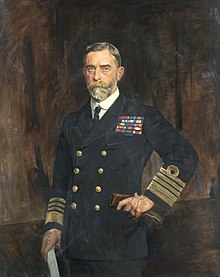Sir Charles Madden, 1st Baronet
| Sir Charles Madden, Bt | |
|---|---|

A portrait of Sir Charles Madden by Reginald Grenville Eves
|
|
| Born |
5 September 1862 Gillingham, Kent |
| Died | 5 June 1935 (aged 72) London |
| Allegiance | United Kingdom |
| Service/branch | Royal Navy |
| Years of service | 1875–1930 |
| Rank | Admiral of the Fleet |
| Commands held |
First Sea Lord Atlantic Fleet 1st Battle Squadron 2nd Cruiser Squadron 3rd Cruiser Squadron First division of the Home Fleet HMS Dreadnought HMS Good Hope |
| Battles/wars |
Anglo-Egyptian War First World War |
| Awards |
Knight Grand Cross of the Order of the Bath Member of the Order of Merit Knight Grand Cross of the Royal Victorian Order Knight Commander of the Order of St Michael and St George Mentioned in Despatches |
Admiral of the Fleet Sir Charles Edward Madden, 1st Baronet GCB, OM, GCVO, KCMG (5 September 1862 – 5 June 1935) was a Royal Navy officer who served during the First World War as Chief of the Staff to Sir John Jellicoe in the Grand Fleet from 1914 to 1916 and as Second-in-Command of the fleet under Sir David Beatty from 1916 to 1919. He was Commander-in-Chief of the Atlantic Fleet after the war and served as First Sea Lord in the late 1920s. In that role, in order to avoid an arms race, he accepted parity with the United States in the form of 50 cruisers defending his position on the basis that he only actually had 48 cruisers anyway.
Born the second son of Captain John William Madden of the 4th (King's Own) Regiment and Emily Madden (née Busby), Madden joined the Royal Navy as a cadet in the training ship HMS Britannia in 1875. Promoted to midshipman he was posted to the central battery ship HMS Alexandra, flagship of Admiral Geoffrey Hornby Commander-in-Chief of the Mediterranean Fleet in 1877 and was deployed to Constantinople during the Russo-Turkish War. He transferred to the corvette HMS Ruby in the East Indies Squadron in 1880. Promoted to sub-lieutenant on 27 October 1881, he was deployed to Suez during the Anglo-Egyptian War and was mentioned in despatches in 1883. He transferred to the battleship HMS Minotaur in the Channel Squadron in September 1883.
...
Wikipedia
